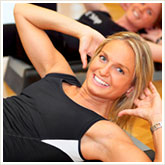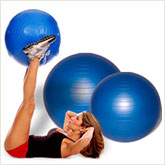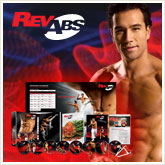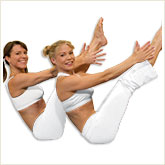Getting to the Core of Your
Ab Routine By Steve Edwards
From Team Beachbody - Click here for resources, tools and
information to help you to reach your health, fitness and positive lifestyle
goals!
Core is the new abs.
Translation: Those chiseled six-packs you
see adorning magazine covers these days are achieved by working the entire
midsection, not just the abdominal muscles. So chuck your Ab Lounge®, your
Ab Roller®, and your 30-second ab routine, and read on to see what could
land you on the cover of Maxim.

This is the part where I confess to a bit of
hyperbole. Those six-packs are mainly a function of the individual's body-fat
percentage, not how strong their core muscles are. Those gimmicky ab workouts
can be okay as part of your program. And hiring a publicist will do
far more for your hopes of appearing in Maxim than any amount of time
in the gym. Oh, and one more thing: most of those models don't look like that
all of the time. As one of them put it to me at a shoot, "I can't wait to eat.
You think I look like this all the time? That would be sooooo unhealthy."
Now that we've got that out of the way,
let's get down to the business of creating a healthy core.
The crunch phenomenon
Isolation training, or training individual
muscle groups, was all the rage for a couple of decades. Probably spurred on by
Arnold in the iconic bodybuilding movie, Pumping Iron, people were
creating exercises to isolate one muscle at a time and blast it into
submission. As these exercises trickled away from Muscle Beach and into the
mainstream, the one that stuck more than any other was the crunch.
 The crunch is a great isolation movement. Plus, it's
relatively easy and you can work your abdominal muscles into a state of rigor
mortis within minutes. And, actually, it worked pretty well for bodybuilders.
After all, they aren't movement-based athletes. And, since they spent so much
time in the gym, isolating the abs wasn't so bad because they isolated every
muscle group. By skipping that last tidbit, this spawned an entire industry of
quick-fix workout gimmicks promising that you, too, could look like Arnold. But
instead of dedicating your entire life to body sculpting, these promised
similar results in a few minutes of ab isolation. The crunch is a great isolation movement. Plus, it's
relatively easy and you can work your abdominal muscles into a state of rigor
mortis within minutes. And, actually, it worked pretty well for bodybuilders.
After all, they aren't movement-based athletes. And, since they spent so much
time in the gym, isolating the abs wasn't so bad because they isolated every
muscle group. By skipping that last tidbit, this spawned an entire industry of
quick-fix workout gimmicks promising that you, too, could look like Arnold. But
instead of dedicating your entire life to body sculpting, these promised
similar results in a few minutes of ab isolation.
The rise of functional
training
Functional training is basically exercising
using movements that you'll encounter in everyday life. It grew out of physical
therapy, which makes sense as more and more people were landing in PT units
because they'd been injured due to isolation training. What they found was that
isolation training was creating muscular imbalances. This is, essentially,
where one muscle group becomes stronger than it's supposed to be compared to
others. When this happens it's easy to get injured.
It's hard to create a muscular imbalance in
your natural life. If you run, for example, your body naturally responds in a
way where it uses all the muscles it can to help the movement. This includes
what are called your prime mover muscles and your stabilizer muscles. In
isolation training, the prime movers would get isolated because those were the
muscles that you could see. This would create major imbalances, and the
stabilizers would often get no attention at all.
Your core and its
function
 Functional training starts with your
core: the middle of your body where virtually all movements begin. A strong
core creates a base to work from. If this base is solid, your chances of
getting injuries decrease greatly. Because of this, functional training
programs spend the majority of their time working on this area. Functional training starts with your
core: the middle of your body where virtually all movements begin. A strong
core creates a base to work from. If this base is solid, your chances of
getting injuries decrease greatly. Because of this, functional training
programs spend the majority of their time working on this area.
This might sound like isolation but it's
not, because your core is not just your abs but all the muscles that connect to
your spine and pelvis. It's essentially all of the prime mover and stabilizer
muscles that you use to stay standing. For this reason, core exercises often
include balance movements. These include using gadgets like
balance
balls, boards that wobble, golf balls, soft balls, and foam rollers, but it
also includes simple old-school movements like push-ups, squats, and many yoga
stances. All of these movements require body awareness (balance) to keep you
from falling over. It's exactly the opposite of a Nautilus® exercise
machine or, say, a crunch.
Is isolation the root of injury and
evil?
Some functional trainers like to tell you
this, but it's not true. There are many reasons why isolation movements still
exist. The main one is sports. Sports create a reason for an athlete to attempt
to exceed their natural physique's strength ability in certain areas. In order
for a muscle to exceed its natural capacity for strength, it must first grow.
Isolation exercises are great for this. So, while fine tools, these are only a
piece of the athlete's pie. To avoid injury and increase performance, athletes
periodize their training, which means they do various cycles of
training that target different goals. Athletes may isolate a muscle group for a
training cycle, but then they must switch their training to functionally train
this new muscle to work within the limitations of their bodies.
Your abs and you
So how does this affect you and how you'll
look at the company beach party? First, the bad news: You won't look like Maria
Sharapova by watching Oprah on your Ab Lounge. The good news, however,
is that you can create a great-looking midsection by training in the way that's
most beneficial to your body.
 This is the
point where I tell you that a true six-pack is a phase. Like I said before,
even most fitness models don't walk around looking chiseled all the time. They
try to stay fit and thin, but the duration of the ultra six-pack is fleeting.
It's the same for many athletes, who will often reduce their body fat to below
healthy levels for increased sports performance (because reduced weight at the
same strength = increase in power output). But they aren't always in this
state. For a six-pack to appear, most men need to get below 10 percent body fat
and women under about 14 percent—abdominal muscle strength has nothing to
do with it. Athletes are better off doing most of their training a little above
this and losing the last bit for competition. This is because body fat helps
your defense mechanisms. Some fat is needed to avoid injury and illness. Where
you are concerned, the state of the six-pack should be something you target for
some photos or, perhaps, a beach party. Your daily life goal should be a slim
midsection. Brett Hoebel's
RevAbs™
workout is ideal for reducing body fat while strengthening your core. This is the
point where I tell you that a true six-pack is a phase. Like I said before,
even most fitness models don't walk around looking chiseled all the time. They
try to stay fit and thin, but the duration of the ultra six-pack is fleeting.
It's the same for many athletes, who will often reduce their body fat to below
healthy levels for increased sports performance (because reduced weight at the
same strength = increase in power output). But they aren't always in this
state. For a six-pack to appear, most men need to get below 10 percent body fat
and women under about 14 percent—abdominal muscle strength has nothing to
do with it. Athletes are better off doing most of their training a little above
this and losing the last bit for competition. This is because body fat helps
your defense mechanisms. Some fat is needed to avoid injury and illness. Where
you are concerned, the state of the six-pack should be something you target for
some photos or, perhaps, a beach party. Your daily life goal should be a slim
midsection. Brett Hoebel's
RevAbs™
workout is ideal for reducing body fat while strengthening your core.
Creating a healthy core
If you will commit to exercising, it's not
all that difficult to ensure that your core is sound. Functional trainers love
to use the word balance. And not just in regards to standing on a wobbly board.
Balance in both your life and how you exercise will help you center yourself in
more ways than one. Here are a few tips to ensure you're getting to the core of
your workouts.
- Work your entire body.
Whatever your workout program is, make sure it works on everything. Not just
your core but your arms, legs, hands, and feet. Everything is connected to your
core, like branches of a tree. Whatever workout program you choose should, at
least a little bit, stress every muscle in your body. No one with an overweight
body has ripped abs. It can't happen.
- Periodize your training.
No matter how great your routine is, change it sometimes. Using
various programs helps you work different muscles and create new engrams
(neuromuscular brain patterns), which results in keeping your body
balanced.
 Do
some yoga or Pilates. Even if you hate it. Yoga, particularly, is the
oldest functional training program there is. You don't need to do Shiva the
destroyer's Power Yoga program. The basic old-school movements will be plenty
to round out your workouts. Or for a fun yoga workout, try Yoga Booty
Ballet® Master Series Yoga Core. Do
some yoga or Pilates. Even if you hate it. Yoga, particularly, is the
oldest functional training program there is. You don't need to do Shiva the
destroyer's Power Yoga program. The basic old-school movements will be plenty
to round out your workouts. Or for a fun yoga workout, try Yoga Booty
Ballet® Master Series Yoga Core.- Do some balance work.
These workouts can be hard, mentally taxing, and kind of boring. But you don't
need to spend 45 minutes balancing on one leg on a skateboard on top of a golf
ball to see results. Just sitting on a balance ball at your desk is very
helpful. Any balance work is better than none.
- Alter your crunch. You
can still crunch, and of course, you still need to work all of your midsection
muscles. A simple balance element, like lifting your legs as you crunch, turns
an isolation ab movement into a core movement. Keeping your legs off the
ground, and straight, contracts something called your transversus
abdominis (TVA). This is the muscle responsible for holding your gut in
(another good TVA exercise is simply sucking your belly button in as far as you
can). You'll start recognizing variations of these movements by staying
present, aware, and observing life, which is another good exercise. Or you can
do crunches with a Squishy Ball, as in the
Yoga
Booty Ballet programs.
|